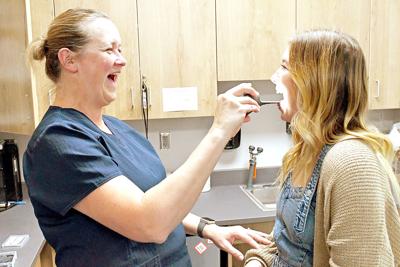SIOUX CENTER—Sioux Center High School students have a new way to talk with a doctor from Sioux Center Health without having to leave the school.
According to Sioux Center School District nurse Sarah TeGrotenhuis, new telehealth equipment helps link her office with the hospital, providing a more convenient option for students and their parents when looking into some basic health questions.
It’s a service that will eventually expand to the district’s other school buildings as well.
The district purchased a TytoCare kit that comes with an ear speculum, a tongue depressing blade and a device that can listen to the heart, lungs and take temperatures; all of these devices connect with one of the two iPads provided to the school by the hospital. The doctor on the other end can then see everything those tools are doing without having to be physically present.
The other iPad is used as a way for the parent of the student, by using FaceTime, to monitor the exam.
For students younger than 18, a parent needs to be a part of medical exams.
“The one we just did, the parent gave permission, called in and she felt the student was old enough to independently talk to the doctors,” TeGrotenhuis said.
In conversations with the Sioux Center Christian School nurse, she’s heard about it being used to look at students with cold-like symptoms. However, they still need to go in to the clinic for a COVID-19 test or a strep throat test if that’s possibly needed.
The devices are useful for examining skin conditions and various infections, including ear infections. It’s also useful for keeping kids in school instead of having to leave to go to the hospital.
“A lot of times, kids will leave for an appointment at 1 and then they won’t come back to school because by the time you get to the doctor and get checked in, it’s a good hour or hour and a half, depending on the wait. With this, I can call the student down right before the actual appointment. To get hooked up to the provider took less than 10 minutes and the student was back in class,” TeGrotenhuis said. “It’s also nice for parents because they can sit at their desk at work and take a 15 minutes break and have an appointment with their child” instead of having to leave for an extended period.
TeGrotenhuis called this technology the future of medicine. With COVID, people are more accustomed to virtual visits, making this a more familiar process than it otherwise would have been, and she sees this kind of technology potentially being used some day for mental health purposes as well.
